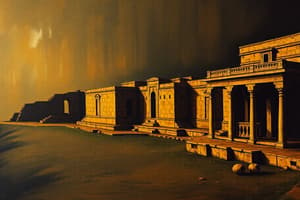Podcast
Questions and Answers
प्राचीन भारत की उत्तर दिशा में कौनसा पर्वत था?
प्राचीन भारत की उत्तर दिशा में कौनसा पर्वत था?
- हिमालय पर्वत (correct)
- अरावली पर्वत
- सतपुड़ा पर्वत
- विंध्य पर्वत
प्राचीन भारत की जलवायु क्या थी?
प्राचीन भारत की जलवायु क्या थी?
- मरुस्थल
- उष्णकटिबंधीय
- समशीतोष्ण
- समशीतोष्ण से उष्णकटिबंधीय (correct)
सिन्धु घाटी सभ्यता के दो प्रमुख शहर कौनसे थे?
सिन्धु घाटी सभ्यता के दो प्रमुख शहर कौनसे थे?
- मोहनजोदड़ो और हड़प्पा (correct)
- चंदीगड़ और पटना
- दिल्ली और अग्रा
- कolkatा और मुम्बई
वैदिक काल में समाज कैसा विभाजित था?
वैदिक काल में समाज कैसा विभाजित था?
मौर्य帝国 की स्थापना किसने की थी?
मौर्य帝国 की स्थापना किसने की थी?
गुप्त帝国 का राजकाल क्या था?
गुप्त帝国 का राजकाल क्या था?
गुप्त帝国 के दौरान क्या उपलब्धि हुई थी?
गुप्त帝国 के दौरान क्या उपलब्धि हुई थी?
प्राचीन भारत की पतन का क्या कारण था?
प्राचीन भारत की पतन का क्या कारण था?
Study Notes
Geography and Climate
- Ancient India was bounded by the Himalayan Mountains to the north, the Indian Ocean to the south, the Arabian Sea to the west, and the Bay of Bengal to the east.
- The Indo-Gangetic Plain, a fertile region between the Himalayas and the Vindhya Mountains, was the cradle of ancient Indian civilization.
- The climate varied from tropical in the south to temperate in the north, with seasonal monsoons bringing heavy rainfall.
Indus Valley Civilization (3300-1300 BCE)
- One of the earliest urban civilizations in the world.
- Major cities: Mohenjo-Daro and Harappa in modern-day Pakistan.
- Advanced features: sophisticated irrigation systems, urban planning, and architecture.
- People: Dravidians, with a possible connection to the Sumerians.
Vedic Period (1500-500 BCE)
- Characterized by the composition of the Vedas, ancient Hindu scriptures.
- Society: divided into four varnas (social classes): Brahmins, Kshatriyas, Vaishyas, and Shudras.
- Politics: janapadas (tribal republics) and mahajanapadas (larger states) emerged.
- Economy: pastoralism and agriculture, with trade and commerce developing.
Mauryan Empire (322-185 BCE)
- Founded by Chandragupta Maurya, who united much of ancient India.
- Capital: Pataliputra (modern Patna).
- Notable rulers: Ashoka the Great, who spread Buddhism and established a centralized bureaucracy.
- Economy: expanded trade, agriculture, and infrastructure development.
Gupta Empire (320-550 CE)
- Often referred to as the "Golden Age" of ancient India.
- Founded by Chandragupta I, with a capital at Pataliputra.
- Notable rulers: Samudragupta, Chandragupta II, and Kumaragupta.
- Achievements: significant advancements in mathematics, astronomy, medicine, and art.
Decline and Legacy
- Ancient India declined due to internal conflicts, foreign invasions, and the rise of regional kingdoms.
- Legacy: significant contributions to world culture, including the development of Hinduism, Buddhism, and Jainism, as well as advancements in science, art, and literature.
भूगोल और जलवायु
- प्राचीन भारत हिमालय पर्वत से उत्तर में, हिन्द महासागर से दक्षिण में, अरब सागर से पश्चिम में, और बंगाल की खाड़ी से पूर्व में सीमित था।
- इण्डो-गंगा मैदान, हिमालय और विंध्य पर्वत के बीच एक उर्वर क्षेत्र, प्राचीन भारतीय सभ्यता काwie था।
सिन्धु घाटी सभ्यता (3300-1300 ईसा पूर्व)
- विश्व की प्राचीनतम नगरीय सभ्यताओं में से एक थी।
- मुख्य नगर: मोहनजोदड़ो और हड़प्पा (आधुनिक पाकिस्तान में)।
- उच्च विशेषताएं: उन्नत सिंचाई प्रणाली, नगर नियोजन, और वास्तुकला।
वैदिक काल (1500-500 ईसा पूर्व)
- वेदों की रचना के द्वारा पहचाना जाता है, प्राचीन हिन्दू धर्मग्रन्थ।
- समाज: चार वर्णों (सामाजिक वर्ग) में विभाजित: ब्राह्मण, क्षत्रिय, वैश्य, और शूद्र।
- राजनीति: जनपद (जनजातीय गणराज्य) और महाजनपद (बड़े राज्य) का उदय हुआ।
मौर्य साम्राज्य (322-185 ईसा पूर्व)
- चन्द्रगुप्त मौर्य द्वारा स्थापित, जिसने प्राचीन भारत का अधिकतर भाग एकीकृत कर लिया।
- राजधानी: पाटलिपुत्र (आधुनिक पटना)।
- उल्लेखनीय शासक: अशोक महान, जिसने बौद्ध धर्म का प्रचार किया और केंद्रीय प्रशासन स्थापित किया।
गुप्त साम्राज्य (320-550 ईस्वी)
- प्राचीन भारत के "स्वर्ण युग" के रूप में जाना जाता है।
- चन्द्रगुप्त प्रथम द्वारा स्थापित, पाटलिपुत्र की राजधानी के साथ।
- उल्लेखनीय शासक: समुद्रगुप्त, चन्द्रगुप्त द्वितीय, और कुमारगुप्त।
- उपलब्धियां: गणित, ज्योतिष, चिकित्सा, और कला में उल्लेखनीय प्रगति हुई।
पतन और विरासत
- प्राचीन भारत में आंतरिक संघर्ष, विदेशी आक्रमण, और क्षेत्रीय राज्यों के उदय से पतन हुआ।
- विरासत: विश्व संस्कृति में उल्लेखनीय योगदान, जिसमें हिन्दू धर्म, बौद्ध धर्म, और जैन धर्म के विकास, विज्ञान, कला, और साहित्य में प्रगति शामिल हैं।
Studying That Suits You
Use AI to generate personalized quizzes and flashcards to suit your learning preferences.
Description
प्राचीन भारत की सीमाओं, मैदानों और जलवायु के बारे में जानें। इंडस वैली सivilization से लेकर प्राचीन भारत के उद्भव के बारे में जानें।




